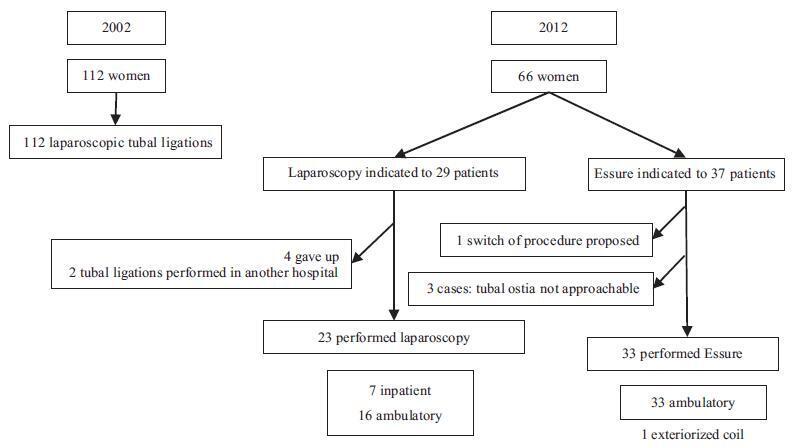Summary
. 2017;39(7):344-349
To evaluate the trends in definitive contraception in a ten-year interval comprising the years 2002 and 2012.
Retrospective analysis of the tubal sterilization performed in our service in 2002 and2012,analyzingthedemographiccharacteristics,personalhistory,previouscontraceptive method, definite contraception technique, effectiveness and complications.
Definitive contraception was performed in 112 women in 2002 (group 1) and in 60 women in 2012 (group 2). The groups were homogeneous regarding age, parity, educational level and personal history. The number of women older than 40 years choosing a definitive method was more frequent in group 1, 49.1% (n = 55); for group 2, the rate was 34.8% (n = 23) (p = 0.04). The time between the last delivery and the procedure was 11.6±6.2 and 7.9±6.4 years (p = 0.014) in 2002 against 2012 respectively. In 2002, all patients performed tubal ligation by laparoscopic inpatient regime. In 2012, the bilateral placement of the Essure (Bayer Corporation, Whippany, NJ, US) device was suggested to 56.1% (n = 37) of the patients, while laparoscopy was suggested to 43.9% (n = 29) of them. All women who underwent laparoscopic sterilization had the procedure successfully completed using silastic rings. The overall bilateral device placement rate for the Essure was 91.6%, with only one complication reported. All Essure procedures were performed in an outpatient setting; for the laparoscopy, this rate was 79% (n = 15). No intentional pregnancies occurred until this date.
There is a trend in the decrease in definitive contraception over the years in our institution, maybe as a result of the development of long-acting reversible contraceptives. The hysteroscopic procedure has become a frequent option, as it is performed in an office setting without anesthesia, being a well-tolerated, minimal invasive method.
